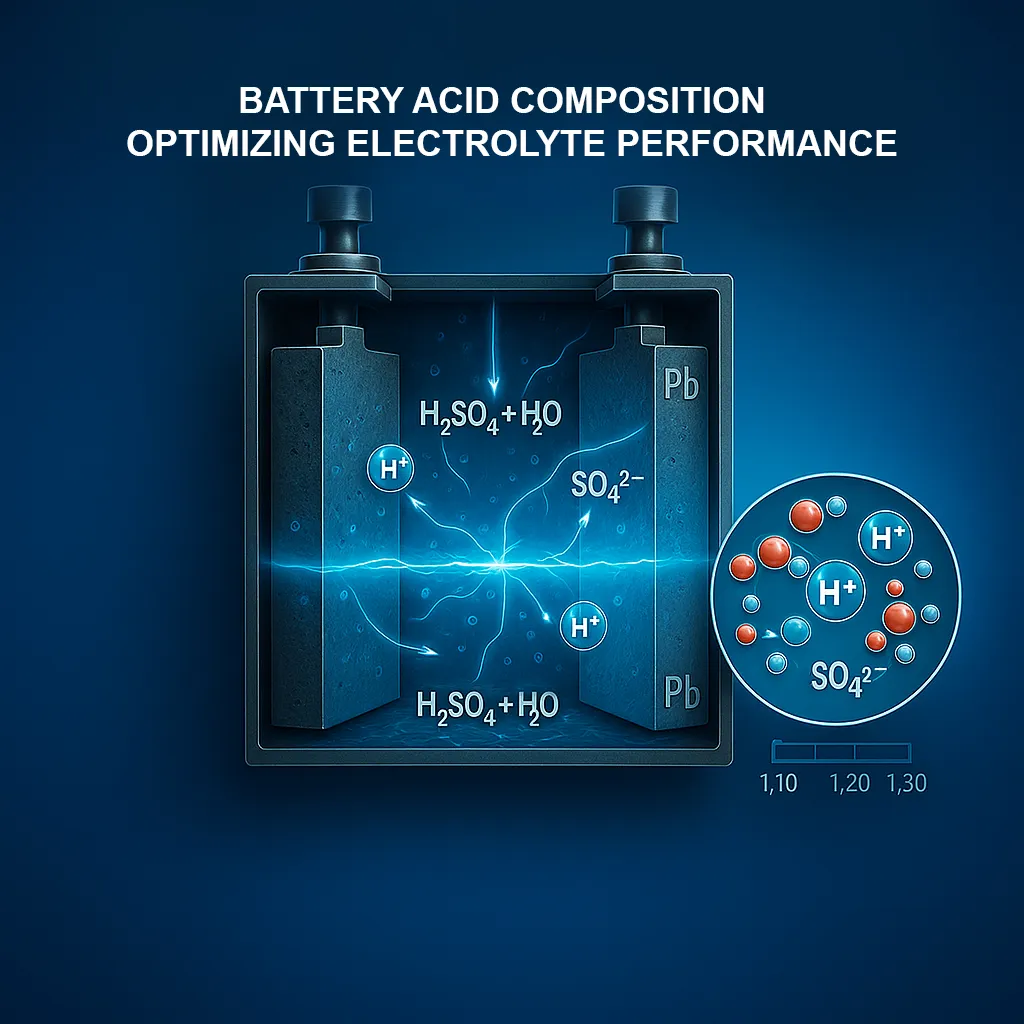Lead-acid batteries power everything from cars to backup generators, relying on sulfuric acid (H₂SO₄) as the electrolyte to drive energy transfer. Optimizing this acid’s composition enhances battery performance, extends lifespan, and ensures safe operation. This article explores the role of battery acid, ideal density ranges, performance-enhancing additives, and critical safety measures for users and manufacturers.
What is Battery Acid?
Battery acid is a diluted solution of sulfuric acid (H₂SO₄) mixed with water, serving as the electrolyte in lead-acid batteries. It interacts with lead (Pb) and lead dioxide (PbO₂) plates to store and release energy. The specific gravity (SG)—a measure of density compared to water—typically ranges from 1.10 to 1.30.
Key functions of battery acid include:
- Ionic Conductor: Facilitates the flow of electric current between battery plates.
- Charge/Discharge Role: Converts to lead sulfate (PbSO₄) during discharge and reverts during charging.
- Performance Impact: Influences voltage, internal resistance, and heat generation.
The optimal SG range for performance is 1.10–1.28, balancing conductivity and reaction efficiency. Lower SG reduces power output, while higher SG (e.g., 1.30) risks corrosion.
Why Electrolyte Composition Matters
The sulfuric acid’s concentration directly affects battery performance and longevity:
- Capacity and Energy Output: Proper acid concentration ensures maximum energy storage and delivery.
- Cycle Life: Balanced acid levels reduce sulfation (buildup of lead sulfate crystals), extending battery life.
- Charge Acceptance: Optimal acid concentration improves recharging speed and cold-cranking ability in low temperatures.
- Corrosion and Water Loss: High SG (above 1.28) accelerates electrode corrosion and water evaporation, shortening lifespan.
Research shows that acid concentration above 1.30 can reduce cycle life by up to 20% due to grid corrosion, while acid concentration below 1.20 impairs cold-cranking performance (Journal of Power Sources, 2019). Tailoring acid density to specific applications (e.g., automotive vs. stationary) is key.
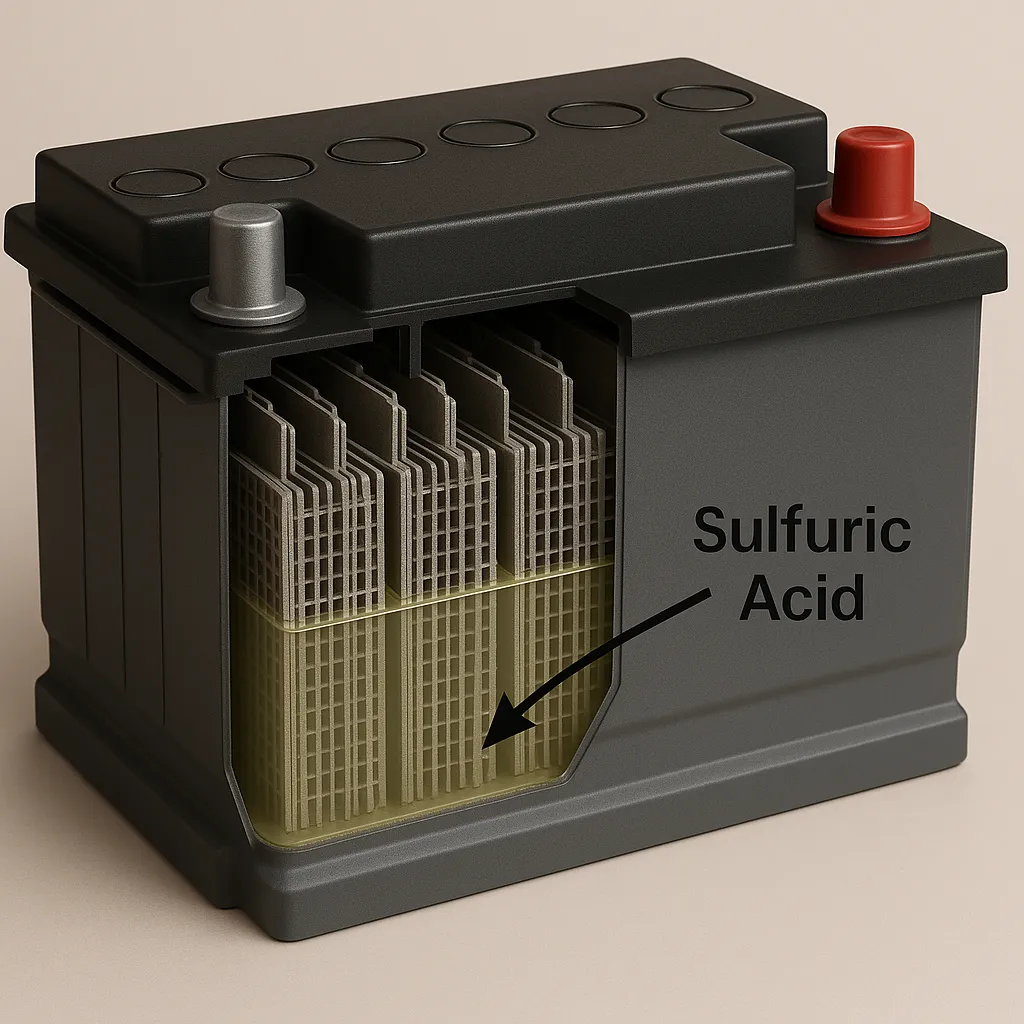
Optimizing Acid Density for Performance
The ideal acid density for lead-acid batteries is 1.24–1.28 g/cm³, based on application needs:
- High Initial Capacity: Achieved at ~1.28 SG, ideal for automotive starter batteries needing burst power.
- Cold Cranking Efficiency: Peaks at ~1.24 SG, enhancing performance in cold climates.
- Cycle Stability: Best at 1.24–1.26 SG, suited for deep-cycle batteries in stationary or renewable energy systems.
Battery types have unique needs:
- Flooded Batteries: Use 1.24–1.28 SG for automotive or industrial use, requiring periodic water top-ups.
- Valve-Regulated Lead-Acid (VRLA)/AGM: Use slightly lower SG (1.22–1.26) to minimize water loss in sealed designs.
Manufacturers must balance immediate performance with long-term reliability, considering climate and usage patterns.
Enhancing Performance with Additives
Additives improve electrolyte stability and battery performance when used in controlled amounts:
- Boric Acid: Reduces water loss and stabilizes reactions, but excess can slow electrochemical activity.
- Ionic Liquids: Minimize hydrogen gas production, reducing corrosion and explosion risks.
- Sodium Sulfate (Na₂SO₄): Enhances charge acceptance in some designs, replacing older additives like antimony (Sb₂O₃) due to environmental concerns.
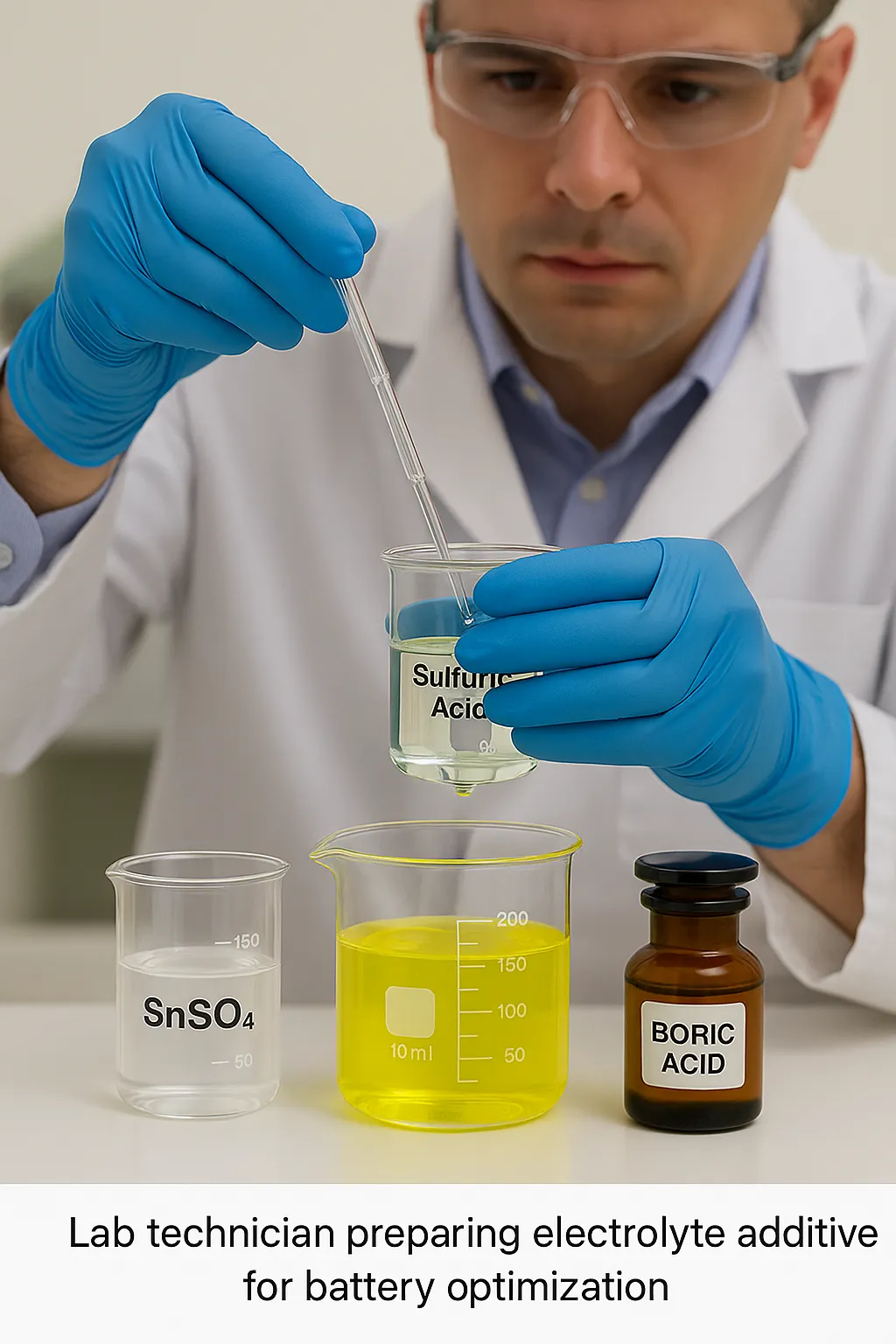
Safety in Design and Handling
Sulfuric acid poses risks like burns and toxic fumes, requiring robust safety measures:
- Sealed Designs (VRLA/AGM): Prevent leaks and reduce fume exposure, ideal for consumer safety.
- Flame Arrestors: Minimize hydrogen ignition risks in flooded batteries.
- Ventilation Systems: Disperse harmful gases during charging or maintenance.
- Personal Protective Equipment (PPE): Gloves, safety glasses, and acid-resistant clothing are essential when handling flooded batteries.
- Spill Management: Neutralizing spill kits (e.g., baking soda) and acid-resistant flooring are critical in industrial settings.
SUZUKI Battery integrates these safety-first innovations—such as sealed VRLA designs and
optimized acid formulations—into every product. Visit the SUZUKI website to explore our
industrial and consumer-grade solutions engineered for performance and safety.
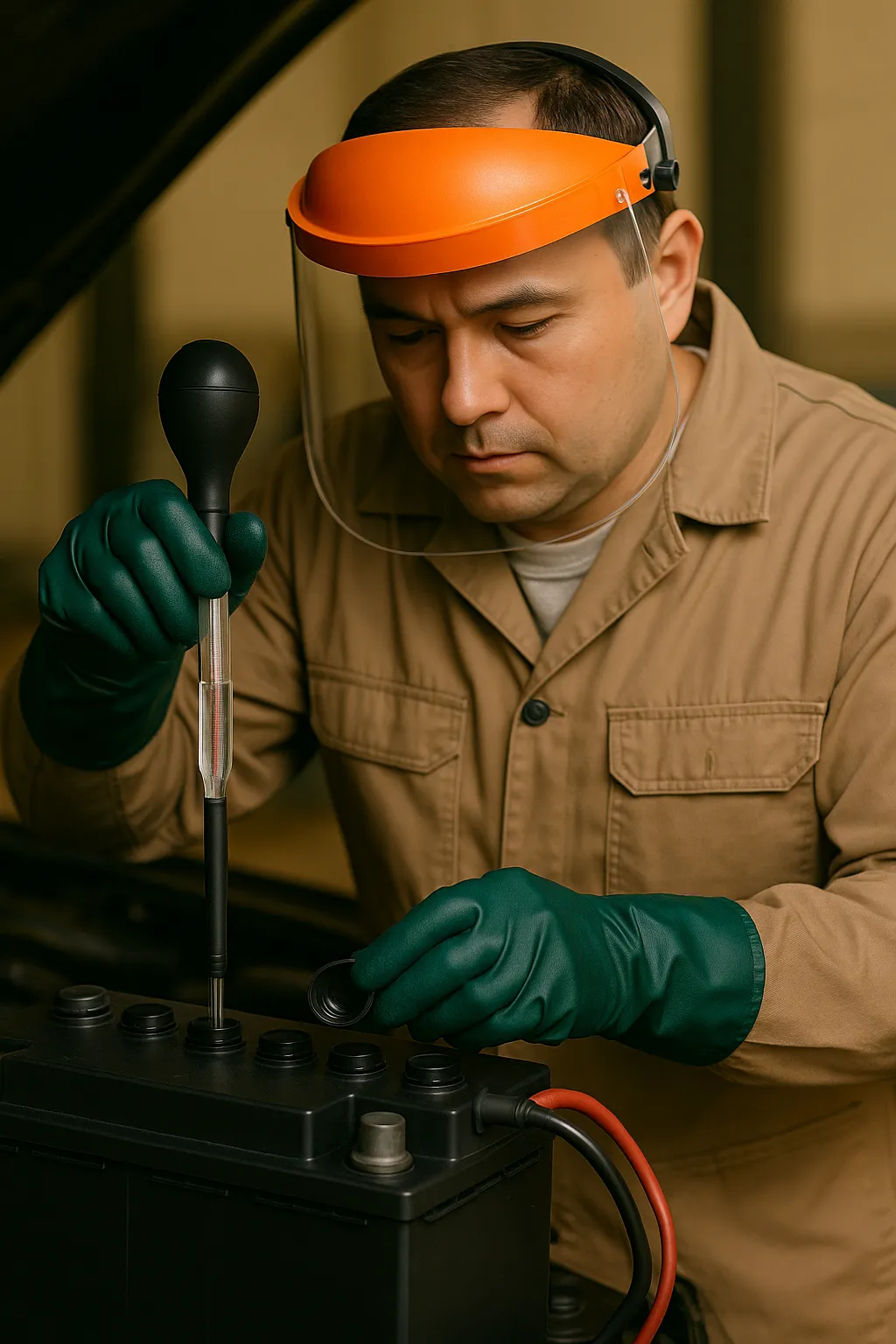
Environmental and Practical Considerations
- Battery Maintenance: Check acid levels monthly in flooded batteries using a hydrometer. Sealed batteries (VRLA/AGM) require no maintenance but should be monitored for charge state.
- Recycling: Dispose of batteries at certified recycling centers to prevent sulfuric acid from harming the environment.
- Temperature Effects: High temperatures accelerate water loss, while cold temperatures reduce capacity. Adjust SG for extreme climates (e.g., 1.26 SG in cold regions).
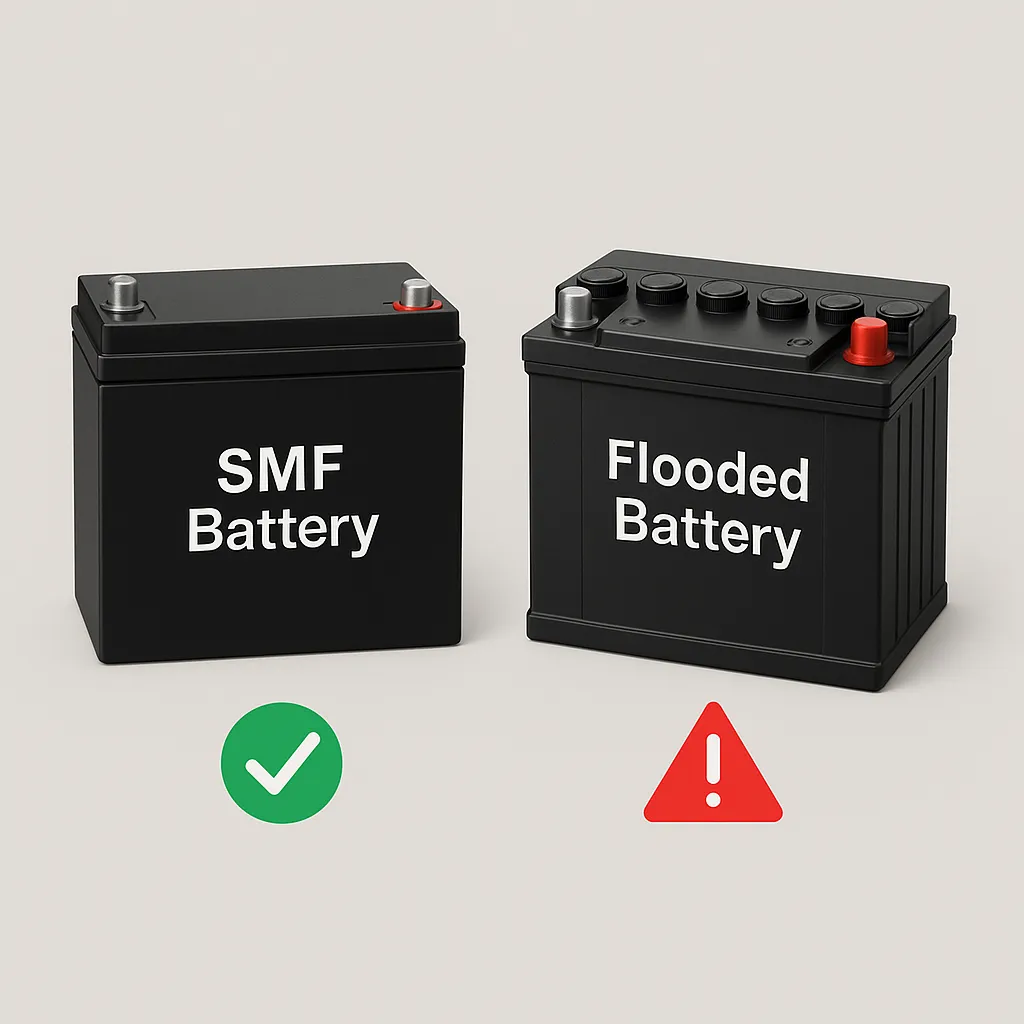
Frequently Asked Questions (FAQs)
Conclusion
Optimizing sulfuric acid composition in lead-acid batteries enhances performance, extends lifespan, and ensures safety. By maintaining an ideal specific gravity (1.24–1.28), using safe additives, and adopting sealed designs like VRLA or AGM, manufacturers deliver reliable and eco-friendly solutions. For users, proper maintenance, safe handling, and recycling are key to maximizing battery life and minimizing risks.
SUZUKI continues to push boundaries in safe energy storage technology, designing batteries
that meet the demands of today’s mobility, industrial, and residential energy markets.
For optimized, safety-enhanced lead-acid batteries tailored to your specific application, visit
the SUZUKI website to learn more.
References (API Format)
- Pavlov, D. (2017). Chapter 3 – H₂SO₄ Electrolyte—An Active Material in the Lead–Acid Cell. Elsevier. https://doi.org/10.1016/B978-0-444-59552-2.00003-1
- Pavlov, D., Petkova, G., & Rogachev, T. (2008). Influence of H₂SO₄ concentration on the performance of lead-acid battery negative plates. Journal of Power Sources, 175, 586–594. https://doi.org/10.1016/J.JPOWSOUR.2007.09.015
- Zhang, Y., Zhou, C., Yang, J., et al. (2022). Advances and challenges in improvement of the electrochemical performance for lead-acid batteries. Journal of Power Sources. https://doi.org/10.1016/j.jpowsour.2021.230800
- Deyab, M. A. (2018). Ionic liquid as an electrolyte additive for high performance lead-acid batteries. Journal of Power Sources. https://doi.org/10.1016/J.JPOWSOUR.2018.04.053
- Yang, S., Li, R., Cai, X., et al. (2018). Enhanced cycle performance and lifetime estimation of lead-acid batteries. New Journal of Chemistry. https://doi.org/10.1039/C8NJ00542G
- Kim, M.-H., Kim, D.-Y., & Jung, J.-W. (2023). Assessment of exposure to sulfuric acid in workers using cleaning equipment operated with lead-acid batteries. Annals of Work Exposures and Health. https://doi.org/10.1093/annweh/wxad081

